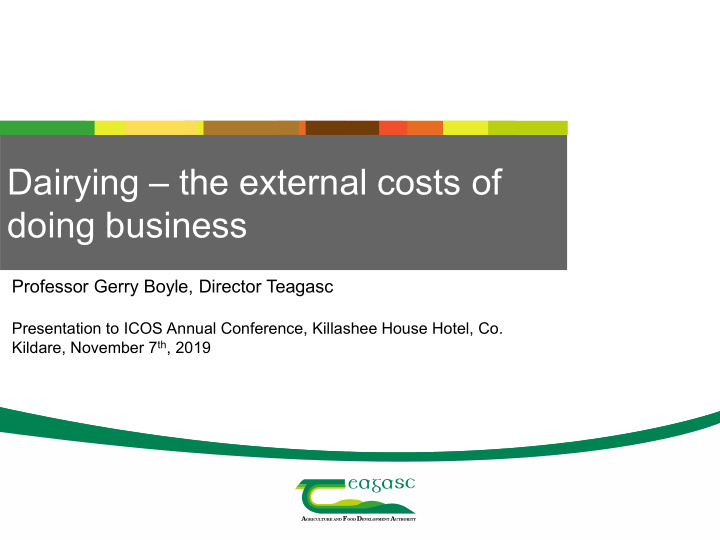



Dairying – the external costs of doing business Professor Gerry Boyle, Director Teagasc Presentation to ICOS Annual Conference, Killashee House Hotel, Co. Kildare, November 7 th , 2019
Evolution of milk production and component Family Farm Income (FFI): includes DPs vs FoodHarvest Base 2011-2017 90,000 Year Milk Cow Numbers Milk Yield/cow Fat % Protein% Production (million)* (lts) 80,000 ( million lts) 70,000 4,932 2007/09 1.005 4,469 3.81 3.33 60,000 (FH Base) €/farm 50,000 160 2014 5,651 1.192 4,740 3.99 3.43 +54% 150 40,000 Production 140 Cows 6,399 2015 1.295 4,938 4.03 3.50 30,000 +43% Yield 130 20,000 6,674 2016 1,347 4,956 4.08 3.46 120 10,000 +18% 110 7,251 2017 1,381 5,249 4.09 3.48 0 100 Dairy Cattle rearing Cattle other Sheep Tillage 90 2007/09 2014 2015 2016 2017 2018 7,576 2011 2012 2013 2014 2015 2016 2017 2018 1,435 5,290 4.14 3.48 * Average of June and December
The external costs Environment • gaseous emissions … GHGs and Ammonia √ Co- related • water quality solutions • biodiversity Calf welfare ICOS Annual Conference 2019 3
The emissions challenge The national emissions target requires a reduction in the absolute level of emissions Emissions have to be reduced by 10%-15% by 2030 while holding livestock numbers constant Emissions = Numbers x Footprint 4
But dairy cow numbers growth exceeds the decline in carbon footprint (2012=100) 130 +5.2% p.a. 125 Footprint 120 Cows 115 110 105 100 95 -2.6% p.a. 90 85 80 2012 2013 2014 2015 2016 2017 ICOS Annual Conference 2019 5
Gaseous emissions – we know what to do – Teagasc MACC ICOS Annual Conference 2019 6
But how to deliver these changes? Transformational change is required and it will cost farmers All of industry collaborative response needed… Agencies (Teagasc and Bord Bia); Industry (Dairy and Meat); DAFM Teagasc proposes an intensive advisory effort embracing 1) ClimateChange Demo/Signpost Farms (~100) and 2) intensive training programme for farmers, agri-business and consultants There is an urgency about delivery ICOS Annual Conference 2019 7
Trends in dairy and beef cows 1600 1400 Dairy Beef Share % 1200 90.0% 80.0% 1000 000 head 70.0% 800 60.0% 50.0% 600 40.0% 400 30.0% Dairy cows Other cows 1980 1983 1986 1989 1992 1995 1998 2001 2004 2007 2010 2013 2016 200 0 1980 1985 1990 1995 2000 2005 2010 2015 Source: CSO December Enumeration
Sustainability of current trends in calf disposals? Slaughterings Exports 30000 200000 180000 25000 160000 140000 20000 Exports 120000 15000 100000 80000 10000 60000 Slaughterings 40000 5000 20000 0 0 2010 2011 2012 2013 2014 2015 2016 2017 2018 2019 ICOS Annual Conference 2019 9
Calf welfare possible urgent actions Working Group to identify actions on calf welfare for next spring Brokerage system to facilitate an efficient flow of calves from dairy to rearing farms (role for the marts?) Transparently demonstrate calf value based on breed and genetics Develop a ‘best in class’ code of practice for calf rearing on dairy and beef farms focusing on animal health and welfare, nutrition and facilities Use sexed semen to reduce the number of dairy breed male calves and establish a sexed-semen laboratory in Ireland Implement a new specific KT programme on dairy beef systems, to include calf rearing Retain male calves on dairy farms for a minimum of 3-4 weeks (subject to adequate facilities) ICOS Annual Conference 2019 10
Concluding remarks There is an urgency about addressing climate change and calf welfare In both cases a ‘whole of sector response’ is needed Dairy and beef need to be treated as an integrated circular system All dairy farmers must accept that the mitigation of gaseous emissions and enabling a viable dairy calf to beef enterprise are costs of doing business ICOS Annual Conference 2019 11
Thank you ICOS Annual Conference 2019 12
Recommend
More recommend